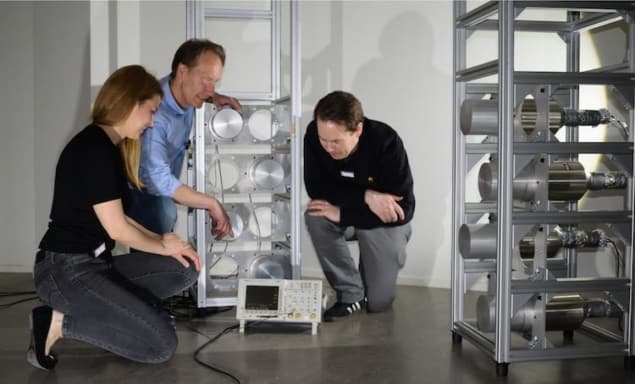
Physicists at the Royal Institute of Technology in Stockholm, Sweden, have developed a new technique to rapidly detect and characterize so-called special nuclear materials like plutonium and enriched uranium. The technique, dubbed neutron-gamma emission tomography, works by measuring the “coincidences” of particles emitted in nuclear fission.
Special nuclear materials are a double-edged sword. As fuel for power stations and reactors, they have enabled great technological advances, but they can damage cities and even threaten human civilization if employed as weapons of mass destruction. They also pose a long-term contamination hazard, from accidents and from potential acts of nuclear terrorism using radiotoxic dispersion devices. Being able to identify, localize and characterize such materials quickly is therefore critical for national security, as well as for detecting radiation leaks and mapping radioactive contamination.
The problem is that the radiation portal monitors commonly used in settings such as airports and seaports are unable to do these things. Instead, they are simply designed to measure the radiation flux as people, vehicles, parcels and other objects pass through them, and set off an alarm if the flux exceeds predefined thresholds. The radiation flux they measure consists primarily of neutrons and gamma photons, both of which are produced during nuclear fission – the decay process by which the nucleus of an atom splits into two or more smaller, lighter “daughter” nuclei.
“Coincidences” of neutron and gamma-ray emissions
In contrast, the new neutron-gamma emission tomography (NGET) technique developed by Bo Cederwall and colleagues can determine the location of special nuclear materials with high precision. It works by measuring the time of arrival of neutrons and gamma photons at specially-designed detector assemblies. The system then looks for “coincidences” – that is, events in which neutrons and gamma rays are detected one after the other – and uses the time-of-arrival information to pinpoint the particles’ source in real time.
“In physics, fast coincidences mean that particles have arrived within a very short time interval, in this case within a couple of 100 nanoseconds or so,” Cederwall explains. “These particles are, in the majority of cases, correlated from the same fission event, or from other types of reactions like alpha-particle induced reactions in the material.”
Test source
The team members demonstrated their new technique using a prototype radiation portal monitor they developed in their laboratory. This system consists of an array of eight 127-mm-diameter by 127-mm-length cylindrical liquid organic scintillator cells arranged in two detector assemblies 1 metre apart. The researchers carried out their tests using a radioactive source of californium-252 (Cf-252) with a mass of 3.2 × 10−9 g, encapsulated in a 4.6-mm × 6-mm cylindrical ceramic casing.
Cf-252 undergoes spontaneous fission, producing an average of 3.76 neutrons per fission event. The source’s total fission rate of roughly 1900 events per second is thus equivalent to that produced by around 100 g of weapons-grade plutonium (7% plutonium-240 and 93% plutonium-241), which would correspond to an object about 1 cm in size.
Not yet optimized
Although Cederwall and colleagues stress that they have not yet optimized their detector for efficiency, nor designed it for imaging, they were nevertheless able to identify the position of their relatively weak test source within an uncertainty of just 4.2 cm. Using a set of more uniformly distributed detectors or smaller detector cells would, they say, substantially improve the detector’s spatial resolution. What is more, while the current study focused on measuring coincidences from a stationary source, the researchers say the method could readily be adapted to moving objects with the aid of an optical tracking system.

Muons: probing the depths of nuclear waste
The researchers, who report their work in Science Advances, say they now plan to try out the NGET technique on different configurations and geometries of portal monitors, including some that might be used for vehicles and freight containers rather than pedestrians. They have also begun a project to analyse the contents of radioactive waste containers. “There is a large global stockpile of temporarily stored radioactive waste – for example, from civil and military nuclear research – which is quite often of unknown detailed composition and origin,” Cederwall tells Physics World. “Such materials need careful characterization before they are disposed of to ensure public safety”.



